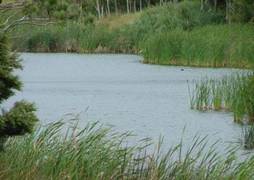9.1 Introduction
The Northland region has a large number of small and generally shallow lakes. They were formed either by dune activity, volcanic activity or are artificially made.
 The dune lakes are in four main groups situated on the Aupouri, Karikari and Pouto peninsulas and the Kai Iwi lakes. They generally range in size between five and 35 hectares and are usually less than 15 metres deep. Lake Taharoa of the Kai Iwi group is one of the largest and deepest dune lakes in the country, covering an area of 237 hectares and being 37 metres deep.
The dune lakes are in four main groups situated on the Aupouri, Karikari and Pouto peninsulas and the Kai Iwi lakes. They generally range in size between five and 35 hectares and are usually less than 15 metres deep. Lake Taharoa of the Kai Iwi group is one of the largest and deepest dune lakes in the country, covering an area of 237 hectares and being 37 metres deep.
Lakes Omapere and Owhareiti near Kaikohe were formed by lava flows damming valleys. Further to the north are two large artificially made lakes associated with the Kerikeri irrigation scheme, which are a major water resource for the area.
Lake policy
Regional Policy Statement
The Regional Policy Statement for Northland (NRC 2002) contains objectives relating to the quality of Northland's surface fresh water resources. These objectives seek to maintain and, where possible, improve water quality in the Northland region. There are also objectives relating to the protection and maintenance of ecosystems and biodiversity.
The Regional Policy Statement (RPS) objectives pertaining to lakes are:
· The maintenance and enhancement of the water quality of natural water bodies in Northland to be suitable, in the long term, and after reasonable mixing of any contaminant with the receiving environment and disregarding the effect of any natural events for the following purposes: Aquatic ecosystems, contact recreation, water supplies, aesthetic and cultural purposes.
· The reduction and minimisation of the quantities of contaminants which adversely affect water bodies, in particular those that are potentially toxic, persistent or bio-accumulative.
· Avoid, remedy or mitigate the adverse effects of discharges of contaminants on the traditional, cultural and spiritual values of water held by tangata whenua.
· Maintenance of the biodiversity of the Northland region.
· Protection of the life supporting capacity of ecosystems through avoiding, remedying or mitigating (in that order of priority) the adverse effects of activities, substances and introduced species on the functioning of natural ecosystems.
· Protection of areas of significant indigenous vegetation and the significant habitats of indigenous fauna.
The following are the anticipated environmental results after the implementation of the water quality policies in the RPS:
- Water quality suitable for desired purposes.
- Contaminants in water bodies reduced.
- The adverse effects of contaminants in water bodies and coastal waters be avoided, remedied or mitigated.
The following are the anticipated environmental results after the implementation of the policies for ecosystems and biodiversity in the RPS:
- An increase in the areas of significant indigenous vegetation and the significant habitats of indigenous fauna which are formally protected.
- No significant increase in the number of threatened species in the region.
Regional Water and Soil Plan
The Regional Water and Soil Plan (RWSP) for Northland (NRC 2007) contains rules that prohibit the discharge of any sewage and animal effluent into the dune lakes listed in Schedule E of the RWSP. Closed systems such as dune lakes are more sensitive to the adverse effects of effluent discharges. Dune lakes have been recognised as having high recreational and aesthetic qualities and are an important tourism feature of Northland. Discharges into any of the dune lakes would threaten those qualities.
